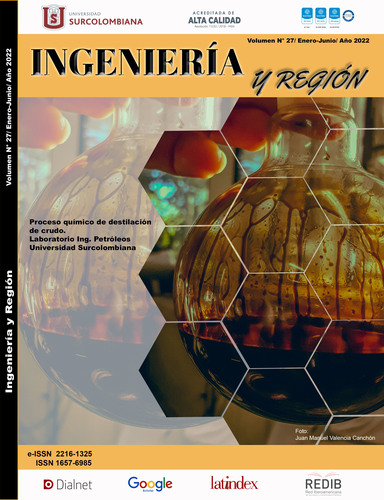Microthermometry of carbonate rocks of the Hondita-Loma Gorda formations, Vereda Bomboná Sector, municipality of Palermo - Huila, Colombia.
##plugins.themes.bootstrap3.article.main##
Geochemical properties in the petroleum industry are used to understand the origin, migration, accumulation, and alteration of hydrocarbons in the basin that contains them. The formation temperature of the rocks of the petroleum system that may be in the hydrocarbon generation window is of utmost importance, as this is the main objective of this article.
The present research used the technique of Microthermometry of fluid inclusions to recognize the formation temperature, homogenization, density, determine some basic physicochemical variables and the salinity of the fluid at the time of trapping, providing evidence about the history of different events in different geological environments in the evolution of the sedimentary basin where the Hondita and Loma Gorda formations belong.
The Hondita and Loma Gorda formations extend along the Upper Magdalena Valley basin, which have been characterized by having the main hydrocarbon producing rocks of the petroleum system.
With the data obtained from Microthermometry, the homogenization temperature and salinity values were estimated, and histograms of homogenization temperature frequencies were made. The salinity vs. homogenization temperature graphs show that the fluid inclusions found in the different samples analyzed have salinities that vary from 19.20% a 20.47% eq. in NaCl weight, similar densities found in the 0.93 a 1.06 g/cc intervals and homogenization temperatures between 120.0°C y 180°C.
The homogenization temperatures obtained indicate that at the time of trapping, the rock was in the medium-light hydrocarbon generation window, which with subsequent diagenetic processes reached the current hydrocarbon characteristics of the Hondita and Loma Gorda formations, as evidenced in many oil fields in the Upper Magdalena Valley area.
Downloads
##plugins.themes.bootstrap3.article.details##
Archer, D. G., 1992. Thermodynamic Properties of the NaCl+H2O System. II. Thermodynamic Properties of NaCl(aq), NaCl⋅2H2(cr), and Phase Equilibria. Journal of Physical and Chemical Reference Data, Vol. 21 No. 4. DOI: https://doi.org/10.1063/1.555915
Ávila, R., 2018. Aumentaron las reservas de petróleo del país. Portafolio.
Bakker, R. J., 2003. Package FLUIDS 1. Computer programs for analysis of fluid inclusion data and for modelling bulk fluid properties. Chemical Geology, 194(1–3), 3–23. DOI: https://doi.org/10.1016/S0009-2541(02)00268-1
Bodnar, R. J., 1993. Revised equation and table for determining the freezing point depression of H2O-Nacl solutions. Geochimica et Cosmochimica Acta, 57(3), 683–684. DOI: https://doi.org/10.1016/0016-7037(93)90378-A
Dunham, R. J., 1962. Classification of carbonate rocks according to depositional textures. Mem. Am. Assoc. Pet. Geol.,1: 108-121.
Ferreira, P., Núñez, A., Rodríguez, M., 2002. Levantamiento geológico de la plancha 323 Neiva. Instituto de investigación e información geocientífica, minero-ambiental y nuclear INGEOMINAS.
Gaona , J., Sánchez, I., 2018. Caracterización diagenética y petrofísica de las rocas carbonatadas fms. Hondita-Loma Gorda, sector cueva del tigre, municipio de Yaguará – Huila, con potencial para yacimientos de hidrocarburos. Universidad Surcolombiana.
González, M., Cruz, L., Vásquez, M., 2009. Informe ejecutivo evaluación del potencial hidrocarburífero de las cuencas colombianas. Fonade-uis-anh.
Mojica, J., Bayer, I., 1987. Características esenciales del Valle Superior del Magdalena, una cuenca Cretácica interandina de Colombia. Aporte Proyecto IGCPUNESCO 242, Cuencas Petrolíferas Cretácicas de América Latina, Tucumán.
Montaño, M. E., 2015. Caracterización y análisis de la formación Loma Gorda, aplicado a la evaluación del potencial como yacimiento no convencional de hidrocarburos, Huila, Valle superior del Magdalena. Universidad Nacional de Colombia.
Patarroyo, P., 1993. Las formaciones cretácicas Hondita y Loma Gorda, a propósito de la nomenclatura estratigráfica del Valle Superior del Magdalena, Colombia. 6 Congr. Col.Geol., Mem. 3. Medellín.
Porta, J., 1965. Estratigrafía del Cretácico Superior y Terciario en el extremo sur del Valle Medio del Magdalena. UIS boletín geológico. Vol. 19, pp. 1–50.
Randive, K. R., Hari, K. R., Dora, M. L., Malpe, D. B., Bhondwe, A. A., 2014. Study of Fluid Inclusions: Methods, Techniques and Applications. Gond. Geol. Mag., Vol. 29, 19–28.
Roncancio, J., Martínez, M., 2011. Upper Magdalena Basin Vol. 14 (p. 183). Medellín, Colombia: ANH-University EAFIT. Department of Geology.
Tissot, B., Durand, D., Espitalie, J., Combaz, A., 1974. Influence of Nature and Diagenesis of Organic Matter in Formation of Petroleum. AAPG Bulletin, Vol. 58. DOI: https://doi.org/10.1306/83D91425-16C7-11D7-8645000102C1865D
Zamora, J., Zuleta, L., Bitar, A., Niño. Alejandro, Escobar, J., Álvarez Camilo., 2021. Informe de gestión 2021. Agencia Nacional de Hidrocarburos ANH.


















